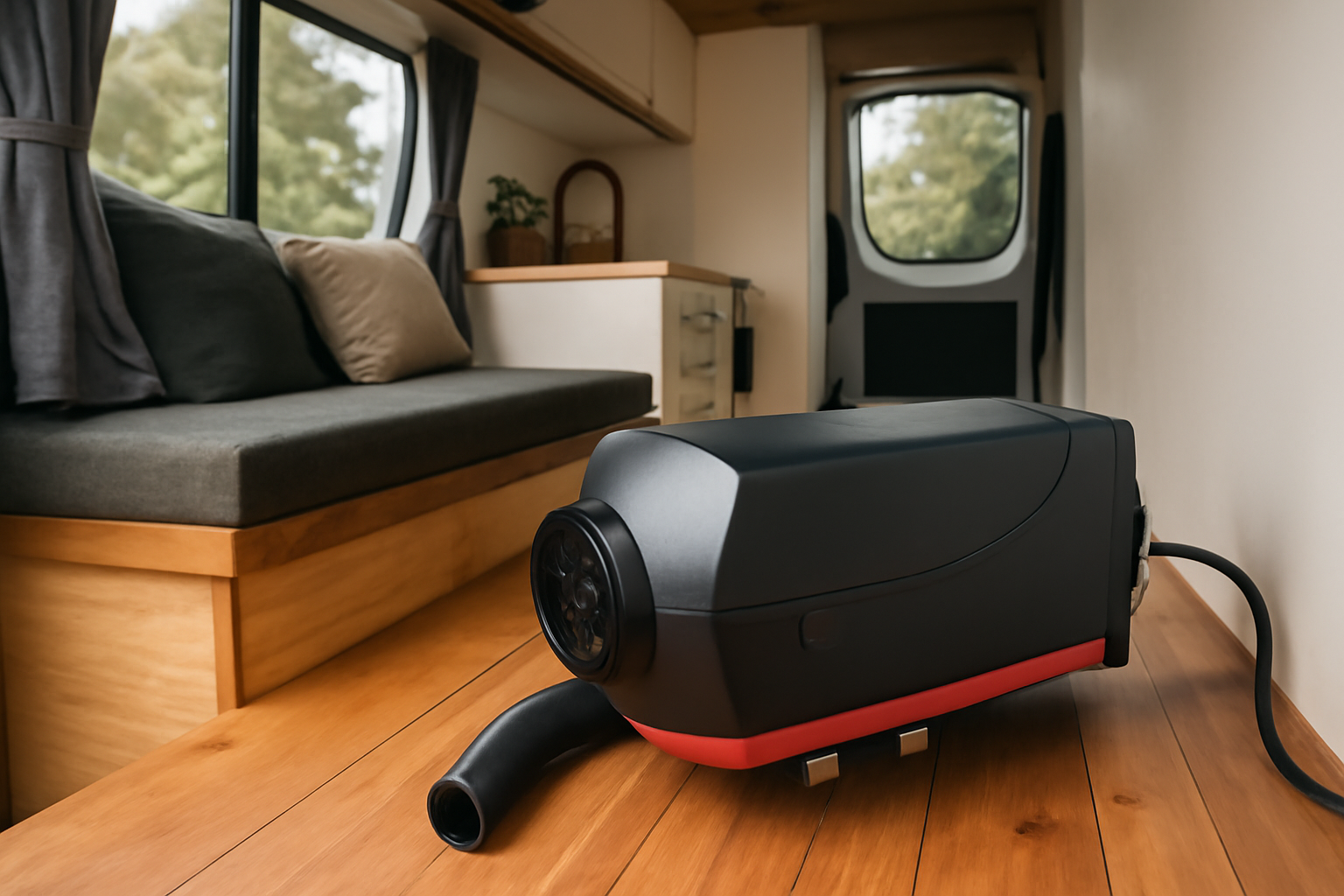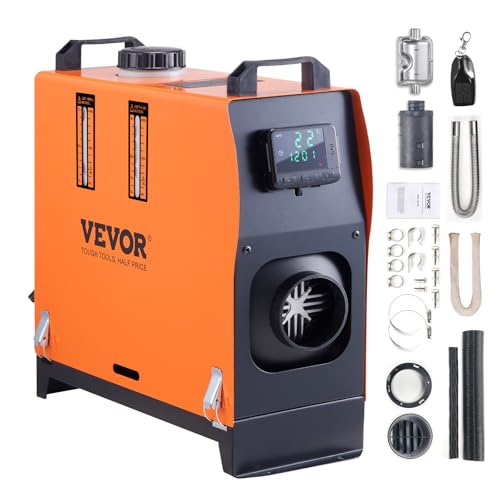Introduction
Let’s get something out of the way—if you’ve ever woken up in a van when it’s 3 degrees outside and your water bottle’s turned into an ice sculpture, you know why diesel heaters matter. And if you haven’t? Congrats on having blood made of lava.
The whole van conversion heater game has changed a lot lately. There are Chinese diesel heater kits for the price of a decent dinner and German-engineered units that cost more than your first car. Some people swear by the Webasto Air Top, others say “just grab a Vevor 5kW and call it a day.” Honestly? They’re both right… depending on what kind of van build you’re working with.
We’re not here to sell you some glow-in-the-dark plastic overpriced fan box. This is a no-fluff breakdown of the top 5 heaters for 2025. We’re talking fuel usage vs runtime, noise levels vs sleep quality, and whether you really need that altitude mode if you’re not camping on Mount Everest.
If you’re serious about vanlife comfort, you’re in the right place. Let’s get warm.
Key Takeaways
- Match heater output to your van size. Bigger isn’t always better.
- Don’t skimp on a CO detector. Safety > savings.
- Chinese heaters work—but check wiring and fuel lines.
- Altitude mode is a must if you camp above 5,000 feet.
- The quietest heaters cost more, but sleep matters.
- Plan your install before you buy. Mounting space, battery capacity, and vent routing all matter.
What to Look for in a Diesel Heater for Van Conversion
Choosing a diesel heater isn’t rocket science—but it sure feels like it when the specs read like airplane manuals. You want to know what it does, how it runs, and if it’ll break down in the middle of the woods. So here’s what actually matters.
Key Features That Matter
Heat Output vs Van Size
If you’re in a short wheelbase van, don’t grab an 8kW beast unless you’re looking to sweat through your mattress. For most conversions, a 2kW or 5kW heater gets the job done. It’s about matching kW rating to cabin volume—not just grabbing the biggest number on the box.
Voltage Compatibility
Most vans use a 12V electrical system, but a few rigs run 24V. A 12V diesel heater plugs right into your house battery system. No converter, no nonsense. Get the voltage wrong, and you’re either frying your heater or wondering why it won’t turn on.
Altitude Setting
Going above 5,000 feet? You’ll need altitude compensation. Some heaters, like the Eberspächer Airtronic, adjust fuel-air mix automatically. Others? They sputter like a lawnmower in molasses.
Installation Considerations
Mounting Locations That Actually Work
Popular spots include under the passenger seat, cargo box, or even tucked near the spare tire bay. Just keep it away from your fuel lines and not directly under your bed unless you like hearing a tiny robot coughing all night.
Tools You’ll Probably Need
- Hole saw (yep, you’ll drill through your van floor)
- Butyl tape (because leaks are not cute)
- Wire crimper, zip ties, and multimeter
And yes, you’ll curse during install. That’s normal. Welcome to DIY vanlife.
Operational Noise & Efficiency
Noise Levels by Brand
- Webasto: whisper quiet
- Autoterm: medium hum
- MaXpeedingrods: sounds like it’s trying its best
Want silence? Install a fuel pump silencer, use rubber grommets, and try not to mount it on a metal plate unless you enjoy rattling echoes at 3 a.m.
Fuel Consumption
Most heaters sip between 0.1 and 0.5 liters per hour. That means a standard 10L tank gets you anywhere from 20 to 90 hours of heat depending on your settings and ambient temps.
Diesel Heater #1: Webasto Air Top 2000 STC
Webasto makes diesel heaters that basically last longer than most relationships. The Air Top 2000 STC isn’t flashy—it just works. Quietly. Consistently. And usually without catching fire, which is a nice touch.
Why It’s on the List
- Webasto Air Top 2000 STC outputs 2kW of heat
- It operates at 12V, perfect for most camper vans
- It’s CE-certified and E-Mark compliant, which your insurance company will love
- Altitude compensation is automatic, so you don’t have to fiddle with it when climbing a mountain
Stuff to Like
- Sound levels are so low, you’ll forget it’s running
- It burns ultra-low sulfur diesel (ULSD) cleanly
- Digital controller options include timers and diagnostic readouts
- Diagnostic software exists—if you want to feel like a spaceship engineer
Stuff to Grumble About
- Price tag feels like a slap, especially compared to the budget options
- Install is DIY-able, but not exactly beginner-friendly
- You’ll probably need to buy extras like ducting and mounts separately
Best For:
People who don’t mind paying extra for German engineering, proven reliability, and near-silent heat while they pretend their van isn’t just a box on wheels.
Diesel Heater #2: Eberspächer Airtronic S2 D2L
Eberspächer designs diesel heaters like they’re trying to win a Formula 1 race in sub-zero temperatures. The Airtronic S2 D2L is their 2.2kW unit, and it runs like it’s been microdosed with logic and caffeine.
Why It’s on the List
- Eberspächer Airtronic S2 D2L outputs 2.2kW of controlled heat
- It supports automatic altitude adjustment up to 9,800 feet
- 12V system compatibility makes it a direct fit for most van setups
- It’s built with OEM-grade components—the kind used in commercial trucks
Stuff to Like
- Low amp draw: less strain on your house batteries
- Includes EasyStart Pro digital controller, so you don’t need a degree to use it
- Super consistent fuel burn = longer runtime and less carbon buildup
- Extensive dealer network in North America if things go sideways
Stuff to Grumble About
- Even pricier than Webasto, and no, it doesn’t come with a golden fuel tank
- Some users report that initial setup menus feel like a bad IKEA manual
- You’ll probably want a professional install unless you like learning the hard way
Best For:
The altitude wanderer who wants automatic compensation, low maintenance, and the peace of mind that comes with commercial-grade parts—and who’s not afraid to drop serious cash.
- Espar diesel heater
- Eberspacher air diesel heater
- Webasto diesel heater
Diesel Heater #3: Autoterm Air 2D (Planar)
The Autoterm Air 2D, formerly known as the Planar 2D, is the sleeper pick on this list. It’s built in Latvia, not Germany or China—and no, that’s not a punchline. This thing punches above its weight.
Why It’s on the List
- Autoterm Air 2D delivers 2kW of heating power
- 12V ready out of the box and built to run on off-road diesel
- Includes full installation kit with manuals that actually make sense
- Trusted by Arctic expeditions and Siberian vanlifers alike
Stuff to Like
- Budget-friendly without being junk
- Clear wiring diagrams, labeled parts, and online tech support that answers emails
- Easy to service—glow plug replacements and cleanouts are DIY-friendly
- Compatible with external digital thermostats
Stuff to Grumble About
- Startup sequence sounds like a mini jet engine waking up
- Doesn’t ship with remote controller by default
- Slightly bulkier than Webasto or Eberspächer units
Best For:
DIYers who want a reliable, mid-priced diesel heater that doesn’t need babysitting and won’t choke at high altitudes—or come with mystery wires and guessing games.
- AUTOTERM Air 2D. Air heater 2 kW (Planar 2D-12)
- Fuel: Diesel
- Voltage: 12V / 24V
Diesel Heater #4: MaXpeedingrods 8KW
If the Webasto is the Mercedes of diesel heaters, the MaXpeedingrods 8KW is that lifted pickup your cousin built in his driveway. It’s loud, bold, and somehow still running.
Why It’s on the List
- MaXpeedingrods 8KW generates massive heat output, best for big vans or freezing climates
- Includes a 12V all-in-one kit, often for under $150
- Comes pre-wired with an LCD controller, remote start, and sometimes even ducting
- One of the most popular models on Amazon—because it’s dirt cheap
Stuff to Like
- Insanely affordable, especially for new vanlifers
- All-in-one box = fewer installation headaches
- Parts are widely available online—because it’s basically a clone of every other Chinese heater
- Surprisingly durable… if you get a good unit
Stuff to Grumble About
- Noise level is high, even with a muffler
- Fuel pump ticks like a woodpecker on Red Bull
- You’ll want to double-check every connection—quality control is hit or miss
- No CE or E-Mark certification, which could be a dealbreaker for EU insurance
Best For:
Budget builders who need maximum heat on a minimum budget, don’t mind tinkering, and treat heater troubleshooting as just another Wednesday.
- 【Bluetooth App—Intelligent & Facilitation】— Downloads “Booyood” App, which enables you to remotely control the heate…
- 【Tool Battery Direct-Plug Power Supply System】This heater breaks through the limitation of traditional heaters relying o…
- 【Powerful Heat Output】— 1KW-8KW adjustable, you can adjust the power according to your heating needs, and the power up…

Diesel Heater #5: Vevor 5KW All-in-One
The Vevor 5KW All-in-One is what happens when Amazon meets vanlife and says, “Yeah, let’s make it idiot-proof.” Everything’s in one tidy metal box—plug it in, fuel it up, and hit the switch.
Why It’s on the List
- Vevor 5KW All-in-One combines heater, pump, tank, and controller into one unit
- Rated at 5kW heat output, suitable for medium to large vans
- Ships fast, often with free returns
- Requires almost no wiring, making it a good choice for non-electricians
Stuff to Like
- Great for renters or temporary van setups—just mount and go
- Remote control, LCD screen, and mounting hardware included
- Faster install time than multi-component kits
- Has a clean metal housing and built-in 10L fuel tank
Stuff to Grumble About
- Doesn’t include high-end components like Eberspächer or Autoterm
- Noise and vibration insulation is minimal
- Heat direction options are limited unless you get creative with ducting
- May arrive with vague instructions or none at all
Best For:
Vanlifers who want a plug-and-play heater without taking apart their floor or routing ducts through their cupboards. It’s not fancy—but it’s functional, fast, and often in stock.
- Easy Installation-free Solution: Enjoy efficient heating with our diesel heater all in one that requires no installation…
- Low Energy Consumption & High Output: Save on fuel costs with vevor diesel heater’s precision low-noise fuel pump, consu…
- Intelligent Dual Control: Take control of your heating experience with our 32 ft long-distance remote control and LCD. P…

Performance Table Comparison
So you’re staring at five heaters and wondering which one doesn’t leave you frozen, broke, or confused. Here’s how the specs stack up:
| Heater Model | Heat Output | Voltage | Noise Level | Price Range | Warranty |
|---|---|---|---|---|---|
| Webasto Air Top 2000 | 2.0 kW | 12V | Very Low | $$$$ | 2 Years |
| Eberspächer S2 D2L | 2.2 kW | 12V | Low | $$$$ | 2 Years |
| Autoterm Air 2D | 2.0 kW | 12V | Medium | $$ | 3 Years |
| MaXpeedingrods 8KW | 8.0 kW | 12V | High | $ | 1 Year |
| Vevor 5KW All-in-One | 5.0 kW | 12V | Medium | $$ | 1 Year |
Notes:
- Price Range Key:
- $ = under $150
- $$ = $150–$300
- $$$$ = $800+
- Noise ratings are subjective but based on average dB levels and user reports.
- Warranties reflect manufacturer claims, not reseller policies.
Common Issues and How to Avoid Them
Even the best diesel heater can act like a toddler on a sugar crash. Here’s what goes wrong most often—and how to keep things warm without losing your mind.
Fuel Pump Ticking
Fuel pumps vibrate and click as they operate, and on budget heaters like the MaXpeedingrods, it’s loud enough to wake squirrels.
Fix It:
- Mount the pump at a 15° angle
- Use rubber isolation mounts or foam padding
- Route the pump line through rubber grommets to reduce cabin noise
Startup Failures
If the heater doesn’t ignite, it’s usually glow plug issues, fuel line air, or low voltage.
Fix It:
- Check for airlocks in the fuel line
- Test battery voltage under load
- Replace a worn glow plug (they’re like the spark plugs of diesel heaters)
Altitude Shutdown
Most heaters get confused above 5,000 feet due to thinner air. Fuel-to-air mix goes out of whack, and the flame sputters.
Fix It:
- Choose a heater with automatic altitude compensation (like Eberspächer S2)
- Manually reduce fuel pump rate if your model allows it
Controller Confusion
You shouldn’t need a PhD to turn your heat on, but some remotes feel like they were designed by bored engineers.
Fix It:
- Replace default controller with a simple rotary dial or digital timer
- Keep a printed quick guide in your van for troubleshooting codes
Carbon Buildup
Short runs = low temps = soot and gunk in your burn chamber. This is especially true with budget models.
Fix It:
- Run your heater at full power for 15–30 minutes weekly
- Use clean diesel or fuel additives to improve combustion
- Schedule a cleanout every season
Safety and Legal Notes
Look, a diesel heater isn’t dangerous if you install it right. But skip steps or ignore warnings, and you’re basically turning your van into a rolling toaster oven with a side of carbon monoxide.
Always Use a CO Detector
Carbon monoxide is odorless, and if your combustion chamber cracks or your exhaust leaks, it doesn’t give you a heads-up—it just knocks you out.
Must-Have:
- Carbon monoxide detector
- Smoke alarm
- Fire extinguisher (mounted near the heater)
Ventilation and Exhaust Rules
Your heater needs outside air for combustion and a safe way to blow that exhaust back out. No, cracking a window doesn’t count.
What to Check:
- Use a stainless steel exhaust pipe, routed outside
- Seal penetrations with high-temp sealant
- Keep the air intake and exhaust pipes separate
Certifications That Actually Matter
If you’re in the EU or planning to insure your rig, make sure your heater is:
- CE-certified (European Conformity)
- E-Mark certified (vehicle safety)
- RoHS compliant (no toxic materials)
Uncertified heaters like some cheap clones might be fine—until your insurance adjuster finds them.
Electrical Precautions
A heater pulling 10+ amps can fry cheap wiring, start a fire, or kill your battery if wired wrong.
Use:
- Proper fuse box
- Marine-grade wiring
- Correct gauge cables
- Battery isolator to protect your starter battery
Final Verdict: Which One’s Right for You?
Let’s face it—no diesel heater is perfect. Each one is built for a different kind of vanlifer, from the broke-but-bold to the “I wired my solar with a spreadsheet” type.
Here’s the no-BS breakdown:
If You’re on a Tight Budget:
Go with the MaXpeedingrods 8KW
- Cheap, powerful, and all-in-one
- Yes, it’s noisy, but it’ll roast your van like a rotisserie
If You Want Near-Silent Luxury:
Pick the Webasto Air Top 2000 STC
- Whisper quiet
- Built to run forever
- Your wallet will cry, but your toes will be warm
If You Travel at Altitude Often:
Get the Eberspächer Airtronic S2 D2L
- Altitude auto-compensation is a game-changer
- Low draw, clean burn, techy but stable
If You Like Doing It All Yourself:
Choose the Autoterm Air 2D
- Mid-priced with real instructions
- DIY-friendly maintenance and controls
- Not too fancy, not too fragile
If You Want Quick Setup with No Fuss:
Grab the Vevor 5KW All-in-One
- Plug-and-play
- Minimal install pain
- Great backup heater or rental van solution
There’s no one-size-fits-all answer—but there is one that fits your build, your climate, and your budget. Pick smart, and stay warm.
FAQ
Can I install a diesel heater myself?
Yes—if you can drill through metal, wire a fuse box, and read diagrams without cursing too much. Otherwise, budget for a pro install.
Will it drain my battery overnight?
Not unless you’ve got a weak battery or a low-quality heater. Most heaters draw between 10–30 watts once running. Startup is where it spikes.
What’s the quietest diesel heater?
The Webasto Air Top is the quietest on this list. Pair it with a silencer and rubber mounts, and you’ll barely hear it.
Can I run it on kerosene or biodiesel?
Some can, but it’s risky. Stick with ULSD (ultra-low sulfur diesel) unless the manual specifically says otherwise.
How do I clean a diesel heater?
Run it on high for 30 minutes once a week. For deeper cleaning, remove the cover and clean the burn chamber, glow plug, and fuel filter.







